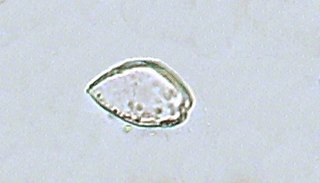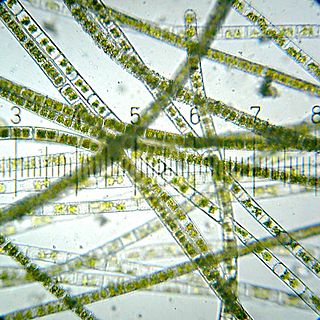
The Prorocentrales are a small order of dinoflagellates. They are distinguished by having their two flagella inserted apically, rather than ventrally as in other groups. One flagellum extends forward and the other circles its base, and there are no flagellar grooves. This arrangement is called desmokont, in contrast to the dinokont arrangement found in other groups. Accordingly, the Prorocentrales may be called desmoflagellates, and in some classifications were treated as a separate class Desmophyceae.

Palmaria palmata, also called dulse, dillisk or dilsk, red dulse, sea lettuce flakes, or creathnach, is a red alga (Rhodophyta) previously referred to as Rhodymenia palmata. It grows on the northern coasts of the Atlantic and Pacific Oceans. It is a well-known snack food. In Iceland, where it is known as söl, it has been an important source of dietary fiber throughout the centuries.

AlgaeBase is a global species database of information on all groups of algae, both marine and freshwater, as well as sea-grass.

Ceratoperidinium margalefii, also known as Ceratoperidinium yeye, is a species of dinoflagellates. This species has two flagella. Their resemblance to the legs of a girl dancing inspired its original name, Ceratoperidinium yeye, in reference to the female-dominated yé-yé pop music and dance of the 1960s.
Dasycladus is a genus of green algae in the family Dasycladaceae. Dasycladus is a marine species.

Zygnema is a genus of freshwater filamentous thalloid alga comprising about 100 species. A terrestrial species, Z. terrestre, is known from India. Zygnema grows as a free-floating mass of filaments, although young plants may be found anchored to streambeds with a holdfast. The filaments form a yellow-green to bright green colored tangled mat, and are composed of elongate barrel-shaped cells, each with two star-shaped (stellate) chloroplasts arrayed along the axis of the cell.
Navicula cari is a species of algae in the genus Navicula. Navicula cari occur in eutrophic waters.

Thalassionema is a genus of Chromista belonging to the family Thalassionemataceae.
Dolichospermum flosaquae is a species of cyanobacteria belonging to the family Aphanizomenonaceae.
Acanthoica is a genus of algae belonging to the family Rhabdosphaeraceae.

Scotinosphaera is a genus of algae belonging to the family Scotinosphaeraceae.
Anomoeoneis is a genus of diatoms belonging to the family Anomoeoneidaceae.
Chroodactylon is a genus of red algae belonging to the family Stylonemataceae.
Aureoumbra is a genus of algae belonging to the family Sarcinochrysidaceae.






